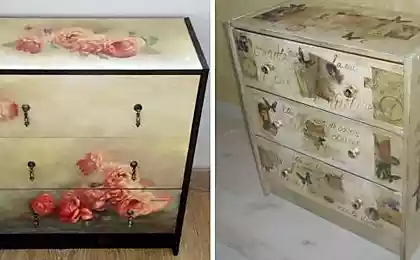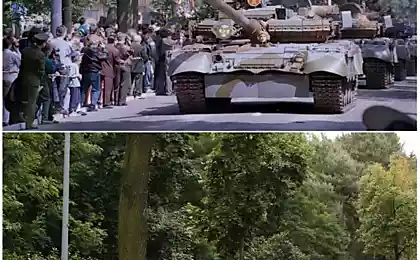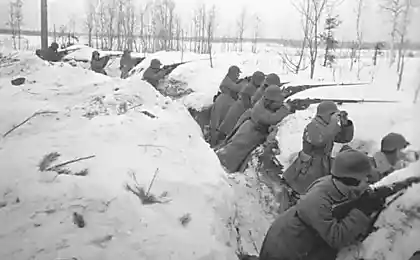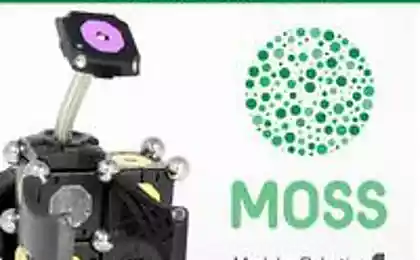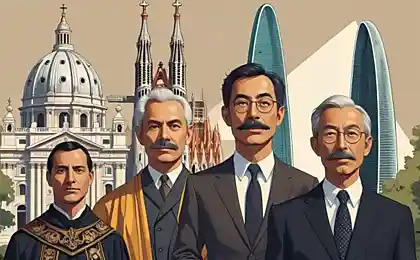1561
Unfulfilled projects of Soviet architecture (13 photos)
In the 30-50-ies of XX century in the Soviet Union had developed an interesting architectural projects that never come true.
Architectural projects in Moscow 30-50-ies are among the most ambitious in the history of the world. Huge buildings, palaces and arches had to embody the power of the world's first socialist state. The most talented architects from various creative schools fought for the right of realization of their projects.
Among all the projects stand out "Master Plan for Reconstruction of Moscow", adopted in 1935. According to this plan in the shortest time Moscow has been transformed into a model and exemplary capital of the world. The whole system of highways, squares and embankments with unique buildings would realize the most beautiful dream of a bright future.
Palace of Soviets
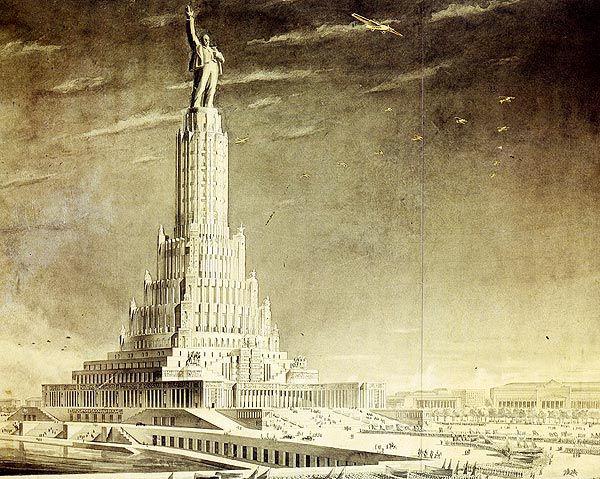
lofan B., O. Gelfreich, O. Shuko. Sculptor S. Merkulov. One embodiment of the approved project. 1934
Competition for the project of the Palace of Soviets in Moscow - one of the largest and most representative architectural competitions of the twentieth century. The competition received 160 projects. 24 proposals were received from foreign participants, among them world-famous architect Le Corbusier, Walter Gropius, Erich Mendelssohn.
The building of the People's Commissariat of Heavy Industry
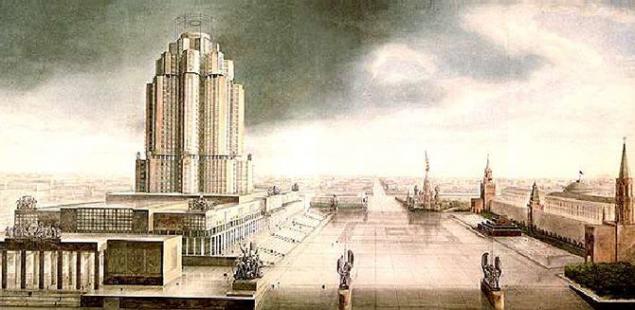
A. Vesnin, VA Vesnin, S. Lyashenko. 1934
In 1934, a competition was announced for the building of the People's Commissariat of Heavy Industry (Narkomtyazhprom) on Red Square. The construction of this grand complex tysych 110 cubic meters over an area of 4 hectares would lead to a radical reconstruction of Red Square and the surrounding streets and squares of the city, China. Impressive projects Vesnin brothers - leaders of constructivism, and have not been awarded by the jury.
Hotel Moscow City Council («Moscow»)
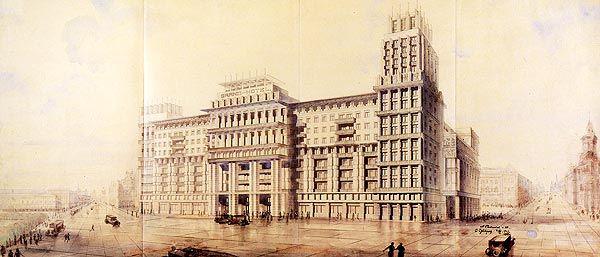
L. Saveliev, A. Ctapran. 1931
In 1931, the Moscow City Council held a closed competition to design a huge hotel on the 1000 numbers, the most well-maintained by the standards of those years. The competition involved six projects, was recognized as the best project of young architects and Stapran Saveliev. The hotel project, its facade, changes were made in the spirit of the new focus on monumentality and classical heritage. According to legend, Stalin signed once both versions of the façade of the building, handed him on a single sheet, resulting in a facade of the hotel was constructed asymmetrical.
Palace of art
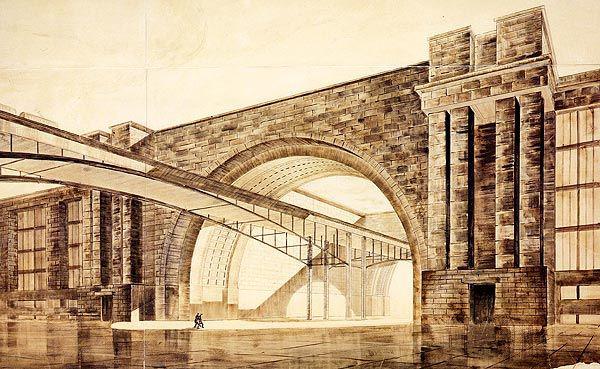
A. Samoilov, Boris Yefimovich. 1933
Competition for the project of the Palace of technology was announced in 1933. The object of design was a complex scientific and technical institutions. He had to "arm the masses of the achievements of Soviet technology in the field of industry, agriculture, transport and communications." Palace construction site was chosen area on the banks of the Moscow River, but the palace was never built.
Military Commissariat building
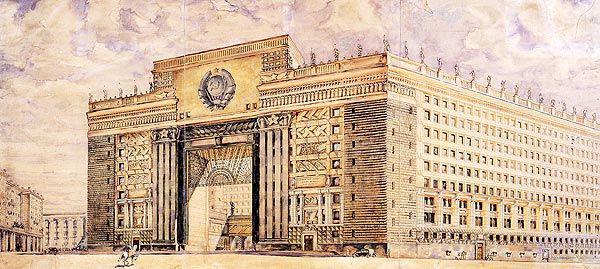
L. Rudnev. 1933
Facilities architect L. Rudnev among the most significant in Moscow. In the 30 years of his projects it was built a number of buildings of People's Commissariat of Defense. For buildings the architect of the agency has developed a special style with motifs formidable impregnability and overwhelming power.
The building of the People's Commissariat of Heavy Industry

Fomin, P. Abrosimov, M. Minkus. 1934
Ivan Fomin: "The two main vertical main facade are to create a gap through which it would be good to look at the mausoleum. According to Sverdlov Square building ends right side of the case. There elected reception silhouette solutions. This end we break very grand arch corresponding to the character of the old architecture of the area. The building plan is a closed ring. Since the composition is closed, we did not want to climb higher as a whole, and only 12-13 floors of the tower will reach a height of 24 floors ».
The building of the People's Commissariat of Heavy Industry
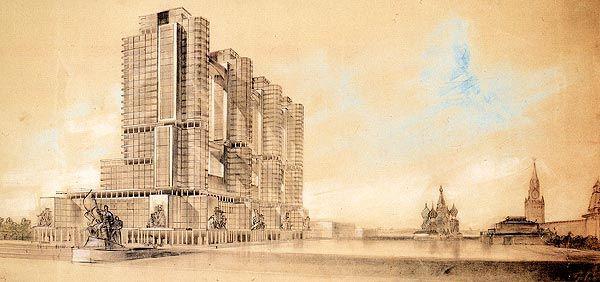
A. Vesnin, VA Vesnin, S. Lyatsenko. Option. 1934
From the explanatory memorandum to the draft "On the podium, answering the Kremlin wall, has four towers, reaching up to 160 meters in height. Rhythmic construction, reflected in four vertical elements of the colonnade and stylobate, creates a visual length required for longitudinal framing square, and meets the construction Kremlin wall ».
House Aeroflot

D. Chechulin. 1934
The building of "Aeroflot", which is planned to build on the area at the Belarusian railway station, was designed by architect Dmitry Chechulin as a monument to the heroic Soviet aviation. Hence ostrosiluetnoe decision and "aerodynamic" form of high-rise housing. The project is in its original form and the appointment was not implemented. Almost half a century later, the general idea of the project was implemented in the complex houses the Supreme Council of the RSFSR on Krasnopresnenskaya Embankment (now Government House).
Book House
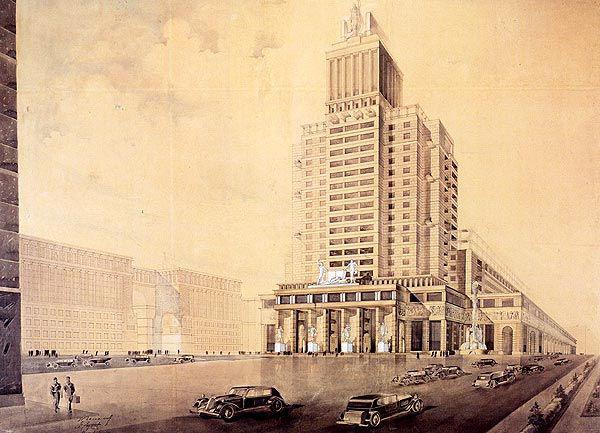
I. Votes, P. Antonov, Zhuravlev. 1934
House Design book - an example typical of the early 30-ies solutions building as "an architectural monument." Trapezoid, soaring silhouette, simplified architectural forms and an abundance of sculptures in all parts of the building.
"Arch of heroes." Monument to the Heroic Defenders of Moscow
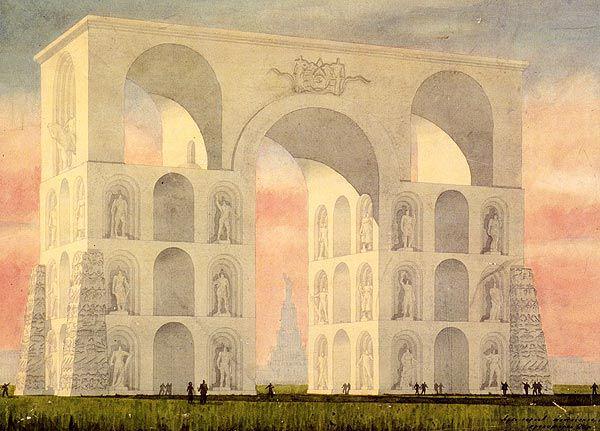
L. Pavlov. 1942
Since October 1942, in the midst of the Great Patriotic War the newspaper "Literature and Art" reported: "Ends contest for monuments to heroes of the Great Patriotic War. From Moscow sculptors and architects, received about 90 works. Get information about projects expulsion from Leningrad, Kuibyshev, Sverdlovsk, Tashkent and other cities of the USSR. It is expected the arrival of more than 140 projects. " The author of "Arch heroes" architect Leonid Pavlov offered to host a monument on Red Square. The monument was built was not.
Residential building on Uprising Square
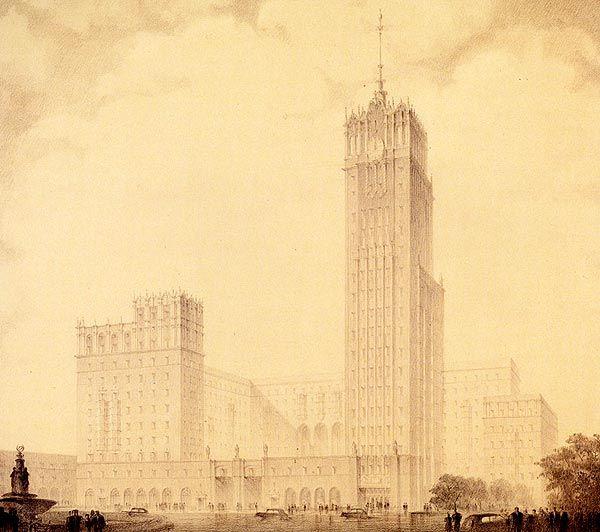
Oltarzhevskaya V., Kuznetsov. 1947
Vyacheslav Oltarzhevskaya much engaged in architectural theory and methods of construction of high-rise buildings. In 1953 he published his book "The construction of high-rise buildings in Moscow," in which he tried to find a connection with the traditions of the architecture of Russian architecture. Particular attention is paid Oltarzhevskaya designs and diverse types of engineering equipment "high-rises».
High-rise building in Zaryadye
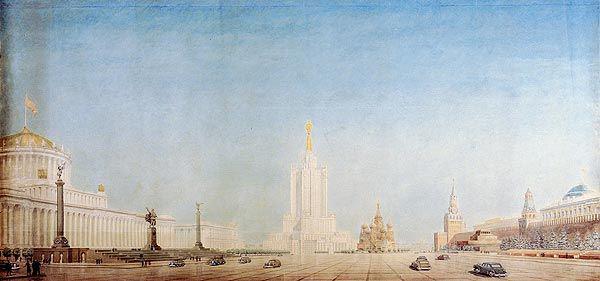
Perspective from the Red Square. D. Chechulin. 1948
In 1947 the Soviet government adopted a decree on the construction of high-rise buildings in Moscow. However, the construction of 32-storey office building in the charge, which was to become one of the main landmarks of the skyline of the city center, has not been completed. Already built structures were dismantled, and on the foundations of high-rise buildings designed by the same Dmitry Chechulina in 1967, built the hotel "Russia».
Palace COUNCIL
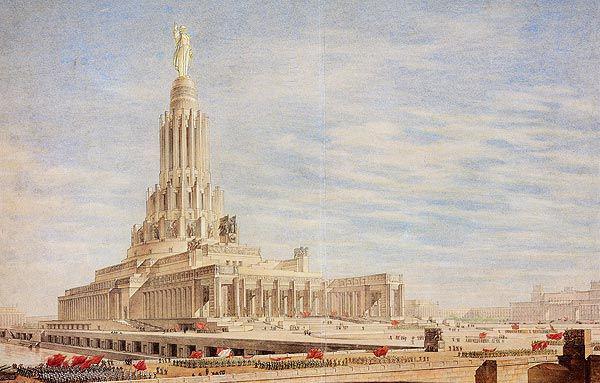
B. lofan V. Gelfreich, J. Belopol'skii, V. Pelevin. Sculptor S. Merkulov.
One embodiment of the approved project. 1946
Palace of the Soviets was conceived as the largest building on earth. Its height should reach 415 meters - above the highest buildings of its time: the Eiffel Tower and the Empire State Building. The building-pedestal was the crowning sculpture of Lenin's height of 100 meters. In this system functioned special laboratories for optics and acoustics, mechanical and acted lightweight aggregate plants, to the construction site was placed upon a separate railway line. In 1941, in connection with the war, construction was halted and never resumed.
Today it is obvious that the best examples of this architecture in a large part and the remaining projects, deeper and more meaningful ideological dogmas in which they are made. Let unrealized projects of the buildings, monuments remind us that we can and must build a new, without destroying the historical values of the past. That gave us a story, whether it is good or bad - it is our history, and we must accept it for what it is.
Architectural projects in Moscow 30-50-ies are among the most ambitious in the history of the world. Huge buildings, palaces and arches had to embody the power of the world's first socialist state. The most talented architects from various creative schools fought for the right of realization of their projects.
Among all the projects stand out "Master Plan for Reconstruction of Moscow", adopted in 1935. According to this plan in the shortest time Moscow has been transformed into a model and exemplary capital of the world. The whole system of highways, squares and embankments with unique buildings would realize the most beautiful dream of a bright future.
Palace of Soviets

lofan B., O. Gelfreich, O. Shuko. Sculptor S. Merkulov. One embodiment of the approved project. 1934
Competition for the project of the Palace of Soviets in Moscow - one of the largest and most representative architectural competitions of the twentieth century. The competition received 160 projects. 24 proposals were received from foreign participants, among them world-famous architect Le Corbusier, Walter Gropius, Erich Mendelssohn.
The building of the People's Commissariat of Heavy Industry

A. Vesnin, VA Vesnin, S. Lyashenko. 1934
In 1934, a competition was announced for the building of the People's Commissariat of Heavy Industry (Narkomtyazhprom) on Red Square. The construction of this grand complex tysych 110 cubic meters over an area of 4 hectares would lead to a radical reconstruction of Red Square and the surrounding streets and squares of the city, China. Impressive projects Vesnin brothers - leaders of constructivism, and have not been awarded by the jury.
Hotel Moscow City Council («Moscow»)

L. Saveliev, A. Ctapran. 1931
In 1931, the Moscow City Council held a closed competition to design a huge hotel on the 1000 numbers, the most well-maintained by the standards of those years. The competition involved six projects, was recognized as the best project of young architects and Stapran Saveliev. The hotel project, its facade, changes were made in the spirit of the new focus on monumentality and classical heritage. According to legend, Stalin signed once both versions of the façade of the building, handed him on a single sheet, resulting in a facade of the hotel was constructed asymmetrical.
Palace of art

A. Samoilov, Boris Yefimovich. 1933
Competition for the project of the Palace of technology was announced in 1933. The object of design was a complex scientific and technical institutions. He had to "arm the masses of the achievements of Soviet technology in the field of industry, agriculture, transport and communications." Palace construction site was chosen area on the banks of the Moscow River, but the palace was never built.
Military Commissariat building

L. Rudnev. 1933
Facilities architect L. Rudnev among the most significant in Moscow. In the 30 years of his projects it was built a number of buildings of People's Commissariat of Defense. For buildings the architect of the agency has developed a special style with motifs formidable impregnability and overwhelming power.
The building of the People's Commissariat of Heavy Industry

Fomin, P. Abrosimov, M. Minkus. 1934
Ivan Fomin: "The two main vertical main facade are to create a gap through which it would be good to look at the mausoleum. According to Sverdlov Square building ends right side of the case. There elected reception silhouette solutions. This end we break very grand arch corresponding to the character of the old architecture of the area. The building plan is a closed ring. Since the composition is closed, we did not want to climb higher as a whole, and only 12-13 floors of the tower will reach a height of 24 floors ».
The building of the People's Commissariat of Heavy Industry

A. Vesnin, VA Vesnin, S. Lyatsenko. Option. 1934
From the explanatory memorandum to the draft "On the podium, answering the Kremlin wall, has four towers, reaching up to 160 meters in height. Rhythmic construction, reflected in four vertical elements of the colonnade and stylobate, creates a visual length required for longitudinal framing square, and meets the construction Kremlin wall ».
House Aeroflot

D. Chechulin. 1934
The building of "Aeroflot", which is planned to build on the area at the Belarusian railway station, was designed by architect Dmitry Chechulin as a monument to the heroic Soviet aviation. Hence ostrosiluetnoe decision and "aerodynamic" form of high-rise housing. The project is in its original form and the appointment was not implemented. Almost half a century later, the general idea of the project was implemented in the complex houses the Supreme Council of the RSFSR on Krasnopresnenskaya Embankment (now Government House).
Book House

I. Votes, P. Antonov, Zhuravlev. 1934
House Design book - an example typical of the early 30-ies solutions building as "an architectural monument." Trapezoid, soaring silhouette, simplified architectural forms and an abundance of sculptures in all parts of the building.
"Arch of heroes." Monument to the Heroic Defenders of Moscow

L. Pavlov. 1942
Since October 1942, in the midst of the Great Patriotic War the newspaper "Literature and Art" reported: "Ends contest for monuments to heroes of the Great Patriotic War. From Moscow sculptors and architects, received about 90 works. Get information about projects expulsion from Leningrad, Kuibyshev, Sverdlovsk, Tashkent and other cities of the USSR. It is expected the arrival of more than 140 projects. " The author of "Arch heroes" architect Leonid Pavlov offered to host a monument on Red Square. The monument was built was not.
Residential building on Uprising Square

Oltarzhevskaya V., Kuznetsov. 1947
Vyacheslav Oltarzhevskaya much engaged in architectural theory and methods of construction of high-rise buildings. In 1953 he published his book "The construction of high-rise buildings in Moscow," in which he tried to find a connection with the traditions of the architecture of Russian architecture. Particular attention is paid Oltarzhevskaya designs and diverse types of engineering equipment "high-rises».
High-rise building in Zaryadye

Perspective from the Red Square. D. Chechulin. 1948
In 1947 the Soviet government adopted a decree on the construction of high-rise buildings in Moscow. However, the construction of 32-storey office building in the charge, which was to become one of the main landmarks of the skyline of the city center, has not been completed. Already built structures were dismantled, and on the foundations of high-rise buildings designed by the same Dmitry Chechulina in 1967, built the hotel "Russia».
Palace COUNCIL

B. lofan V. Gelfreich, J. Belopol'skii, V. Pelevin. Sculptor S. Merkulov.
One embodiment of the approved project. 1946
Palace of the Soviets was conceived as the largest building on earth. Its height should reach 415 meters - above the highest buildings of its time: the Eiffel Tower and the Empire State Building. The building-pedestal was the crowning sculpture of Lenin's height of 100 meters. In this system functioned special laboratories for optics and acoustics, mechanical and acted lightweight aggregate plants, to the construction site was placed upon a separate railway line. In 1941, in connection with the war, construction was halted and never resumed.
Today it is obvious that the best examples of this architecture in a large part and the remaining projects, deeper and more meaningful ideological dogmas in which they are made. Let unrealized projects of the buildings, monuments remind us that we can and must build a new, without destroying the historical values of the past. That gave us a story, whether it is good or bad - it is our history, and we must accept it for what it is.




